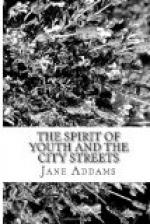Already some American cities are making a beginning toward more adequate public recreation. Boston has its municipal gymnasiums, cricket fields, and golf grounds. Chicago has seventeen parks with playing fields, gymnasiums and baths, which at present enroll thousands of young people. These same parks are provided with beautiful halls which are used for many purposes, rent free, and are given over to any group of young people who wish to conduct dancing parties subject to city supervision and chaperonage. Many social clubs have deserted neighboring saloon halls for these municipal drawing rooms beautifully decorated with growing plants supplied by the park greenhouses, and flooded with electric lights supplied by the park power house. In the saloon halls the young people were obliged to “pass money freely over the bar,” and in order to make the most of the occasion they usually stayed until morning. At such times the economic necessity itself would override the counsels of the more temperate, and the thrifty door keeper would not insist upon invitations but would take in any one who had the “price of a ticket.” The free rent in the park hall, the good food in the park restaurant, supplied at cost, have made three parties closing at eleven o’clock no more expensive than one party breaking up at daylight, too often in disorder.
Is not this an argument that the drinking, the late hours, the lack of decorum, are directly traceable to the commercial enterprise which ministers to pleasure in order to drag it into excess because excess is more profitable? To thus commercialize pleasure is as monstrous as it is to commercialize art. It is intolerable that the city does not take over this function of making provision for pleasure, as wise communities in Sweden and South Carolina have taken the sale of alcohol out of the hands of enterprising publicans.




